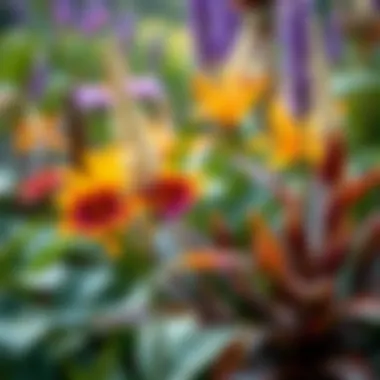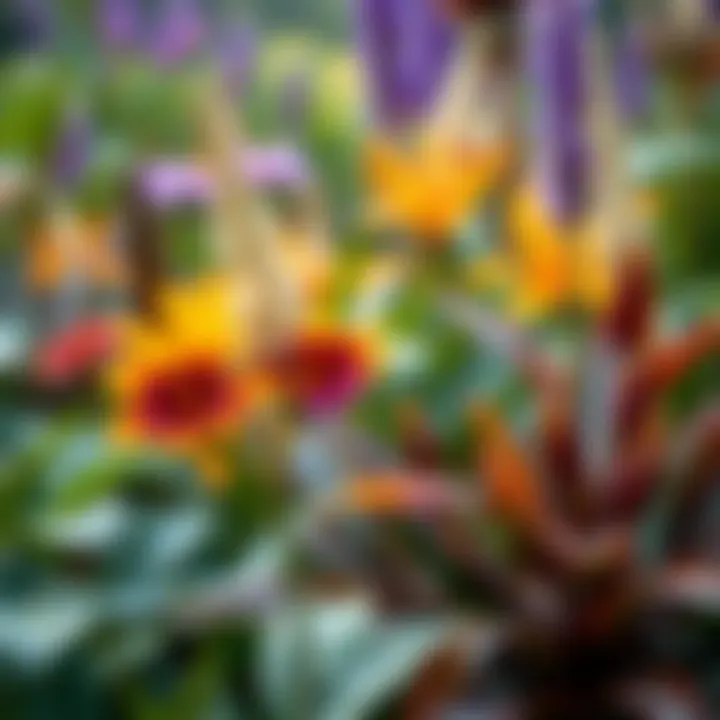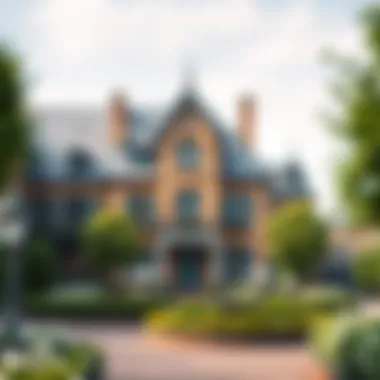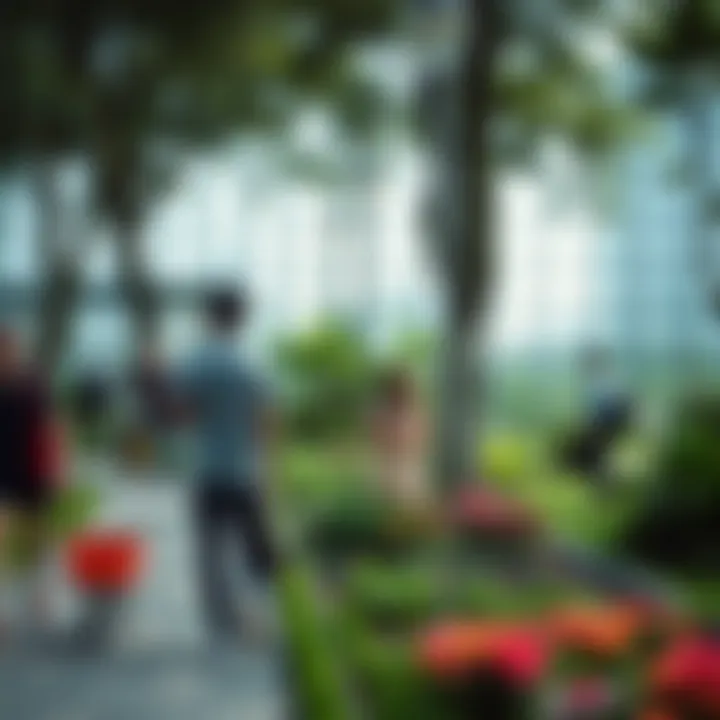Exploring Holland Gardens: Unique Urban Landscapes


Intro
Holland Gardens stand as a testament to innovative urban landscaping, blending nature and architecture in a way that is not only visually appealing but also vital for ecological balance. In a bustling metropolis like Dubai, where concrete and glass dominate, the nurturing touch of greenery becomes essential for community well-being and biodiversity. It’s not just about aesthetics; these gardens play a significant role in enhancing property values and creating serene spaces amidst the urban chaos.
An exploration of these gardens reveals much more than just flowers and trees. It unveils a narrative of historical significance, careful design principles, and an understanding of their impact on urban life. In this article, we’ll dissect the elements that make Holland Gardens remarkable, the trends shaping their evolution, and the investment opportunities that accompany these green havens. From analyzing the current market conditions to spotlighting promising neighborhoods, this guide aims to equip real estate investors, property seekers, and urban enthusiasts with the insights needed to appreciate the multifaceted value of these landscapes.
Understanding Holland Gardens
Holland Gardens offer more than just a slice of greenery in an urban ecosystem; they are a manifestation of nature’s intricate beauty and a testament to sustainable design practices. Their thoughtful integration into city landscapes presents numerous benefits for residents and urban planners alike. By understanding these gardens, investors and homebuyers can appreciate their significant contribution to enhancing urban environments and increasing property values.
Through the lens of ecology, Holland Gardens act as vital green spaces that not only beautify their surroundings but also serve as vital air purifiers and biodiversity hotspots. Key aspects like historical backgrounds, design elements, and cultural significance form a rich tapestry that showcases the importance of these gardens in Dubai's bustling landscape.
With this understanding, the discussion can unfold into the intricate details of how these gardens are designed and the historical factors that shaped them. Furthermore, comprehending the pressing need for green spaces in an increasingly urbanized world provides essential insight for investors looking to leverage the allure of well-planned gardens in real estate markets.
Historical Background
The historical context of Holland Gardens enriches our understanding of their presence in modern urban settings. Many of these gardens draw inspiration from traditional Dutch horticultural practices, establishing a strong sense of cultural identity. The evolution of these gardens reflects changes in landscape architecture and urban design through various eras, revealing how historical experiences influence architectural choices and sustainability practices today.
Design Elements
Holland Gardens are recognized for a unique blend of aesthetic charm and ecological functionality. Three key design elements contribute significantly to their overall character:
Plant Selection
Selecting the right plants is paramount in creating a thriving Holland Garden. This involves choosing species that not only survive in the local climate but also promote biodiversity. The key characteristic of plant selection is its focus on native species, which helps maintain the ecosystem's balance. Native plants often require less maintenance and contribute to a more resilient garden layout. A unique feature is the layering approach, which enhances visual appeal and allows for varied habitats for local wildlife. However, it requires careful planning to avoid overwhelming the layout with vegetation.
Landscaping Techniques
Landscaping techniques in Holland Gardens vary but often center around the concept of harmony with nature. Key characteristics include the incorporation of natural forms and the use of organic materials, fostering a seamless transition between the garden and its surrounding environment. One beneficial aspect of these techniques is their role in managing rainwater through strategic planting and soil management. A unique element can be the use of contouring, creating gentle slopes that not only adds aesthetic value but also assists with drainage. Challenges can arise in maintaining these features, especially in extreme weather conditions.
Water Features
Water features are both a focal point and a functional element in Holland Gardens. They serve to enhance the tranquil atmosphere while attracting various animal species. A key aspect is the use of reflective surfaces that create visual depth and complex interactions with light. These features can aid in rainwater management by providing natural drainage and reducing pooling. The incorporation of such water elements, while beneficial, can demand substantial upkeep and may incur costs related to water quality management and system maintenance.
Cultural Significance
Culturally, Holland Gardens represent a blend of community engagement and artistic expression. They often become gathering spots for various community activities, fostering social interactions and promoting mental well-being. The ability of these gardens to create spaces for reflection and recreation underscores their importance in urban environments. The gardens are also a canvas for public art and seasonal events, paving the way for cultural celebrations that engage diverse demographics. The role of these gardens extends beyond mere aesthetics; they are woven into the social fabric of their locales, enabling connections that can be nurturing and transformative.


In understanding Holland Gardens, it becomes clear they are vital to reflecting the community’s cultural heritage while providing environmental benefits. Engaging with and valuing these gardens comprehensively also offers deep insights into the importance of integrating nature into urban planning.
Types of Holland Gardens
Holland Gardens serve more than just an aesthetic purpose in urban settings; they play a pivotal role in enhancing the quality of life. Here, we break down the types of Holland Gardens and what makes each of them distinct.
Formal Gardens
Formal gardens epitomize order and symmetry, making them a hallmark of sophisticated design. Typically laid out on geometric grids, these gardens utilize well-defined pathways and manicured hedges to create a sense of elegance. The design elements might include boxwood parterres or neatly trimmed flowering beds.
- Style and Structure: Formal gardens often employ a series of interlinking areas that emanate a sense of grandeur. Think of expansive terraces dotted with fountains that draw the eye.
- Plant Choices: Popular plants in formal gardens include roses and topiaries, effectively maintaining a polished appearance year-round. The idea is to create a structured dialogue between flora and hardscape.
- Maintenance Consideration: It’s worth noting that while these gardens can be breathtaking, they require considerable upkeep. Regular pruning and meticulous care are essential to sustain their immaculate allure.
"A well-ordered garden certainly reflects a well-ordered mind"
Naturalistic Designs
Naturalistic gardens, in contrast to their formal counterparts, embrace the unpredictability of nature. They often mimic natural landscapes, utilizing native plant species and organic shapes. This type encourages a diverse ecosystem that can dynamically change with the seasons.
- Flora Diversity: Native flora is frequently chosen for their adaptability, aiding in local biodiversity. Utilizing local species not only nurtures the environment but also minimizes water usage.
- Ecosystem Services: These gardens can offer vital services such as habitat for local wildlife and improved pollination rates. One might say they turn a mundane space into a thriving heart of nature.
- Sustainability: The emphasis on sustainability is evident through techniques like xeriscaping, where drought-resistant plants are selected, significantly lowering water consumption requirements.
Community Gardens
Community gardens represent the spirit of cooperation and local engagement. These gardens are often born out of an organic desire from residents to create shared green spaces within densely populated urban environments.
- Social Connection: They function as social hubs, bringing together diverse groups, fostering relationships, and nurturing a sense of belonging. Typically, they cultivate not just plants but also community bonds.
- Educational Opportunities: Many community gardens incorporate educational programs about gardening techniques, nutrition, and sustainable practices, further enhancing their community role.
- Local Produce: The yield from these gardens often finds its way into local kitchens, providing fresh produce and promoting healthier lifestyle choices among residents.
The Role of Green Spaces in Urban Development
The significance of green spaces in urban settings goes far beyond mere aesthetics. In a world where concrete jungles abound, having access to greenery can make a meaningful difference in the livability of cities. Holland Gardens exemplifies this notion, as these landscaped areas not only enhance the visual appeal of urban spaces but also interact deeply with the ecosystem and the communities surrounding them.
Enhancing Aesthetic Appeal
A well-designed garden does wonders for the eye. Imagine strolling through a lush patch of flora while the sun filters through fluttering leaves. Gardens can serve as a visual retreat amidst the hustle and bustle of daily life. They provide a splash of color and serenity which can transform a mundane street into a vibrant community hub.
- Landmarks: Iconic gardens become landmarks, drawing tourists and locals alike, adding economic vitality to the area.
- Architectural Cohesion: Planned greenery can harmonize with surrounding buildings, offering a seamless blend between nature and structure that astounds residents.
- Curb Appeal: For property values, well-maintained gardens can create an appealing environment, making nearby homes more attractive to potential buyers.
Improving Air Quality


In urban environments, air quality can often take a nosedive due to pollution from vehicles, industries, and other sources. The incorporation of green spaces plays a crucial role in mitigating these effects. Plants absorb carbon dioxide while releasing oxygen, and their presence can lead to an undeniable improvement in air quality.
- Pollutant Reduction: Gardens can trap dust, pollutants, and particulate matter, leading to cleaner air in densely populated regions.
- Oxygen Production: The contribution of plants to oxygen levels in the air not only enhances overall health but also provides a more refreshing experience for its users.
- Temperature Regulation: Through the process of evapotranspiration, green spaces can help cool surrounding areas, ultimately leading to reduced energy use in nearby buildings.
Supporting Biodiversity
Urban areas often suffer from diminished biodiversity due to habitat loss. However, the introduction of gardens can act as vital sanctuaries for various species. Holland Gardens not only beautify the landscape but also offer refuge for wildlife.
- Habitat Creation: Gardens provide essential habitats for birds, insects, and other wildlife, fostering a healthy ecosystem.
- Pollinator Support: By planting diverse species, gardens can attract important pollinators such as bees and butterflies, which are crucial for food production and ecological stability.
- Education and Awareness: Community gardens can serve as educational platforms, encouraging environmental consciousness among residents and fostering a sense of stewardship toward local ecosystems.
"Green spaces are not just an ornamental aspect of urban planning; they are essential components that enrich our environments, our health, and our quality of life."
The thoughtful integration of green spaces into city designs may create a liveable and enduring urban habitat that benefits residents and supports nature's intricate web of life.
Holland Gardens and Real Estate Value
When diving into the relationship between Holland Gardens and real estate value, it becomes evident that the integration of green spaces into urban settings can significantly influence property markets. The presence of vibrant gardens not only adds a layer of aesthetic appeal but also serves as a way to enhance the livability of communities, making properties more desirable. It's more than just a splash of color in a concrete jungle; it speaks to lifestyles that prioritize health, well-being, and skilled design.
Impact on Property Prices
Property values in urban areas have shown a trend towards increased worth when a well-maintained garden is in proximity. Research suggests that homes situated near Holland Gardens can see their market values rise appreciably, sometimes reaching upwards of 15% compared to homes located distantly from such green spaces. This uptick is often due to potential buyers' perceptions—they're drawn to the lush greenery and the sense of calm it provides, a stark contrast to the usual bustle of city life.
"Properties near well-designed gardens often attract a higher selling price due to the lifestyle appeal associated with green spaces."
Moreover, in cities like Dubai, where the urban landscape is continually evolving, the demand for properties that boast direct access to landscaped gardens becomes competitive. The aesthetic benefits and potential for recreational space cannot be overstated, as they offer not just visual delight but also a sanctuary from the typical stresses of city living.
Attracting Buyers
The appeal of Holland Gardens extends into the realm of attracting buyers. These gardens project a desire for sustainability and environmental consciousness, which resonates particularly with modern homebuyers. More than just a pretty garden, these spaces tell a story about the lifestyle potential they bring with them.
Having a well-planned garden nearby can serve as a powerful marketing tool for property agents and developers. Buyers often envision themselves walking through lush pathways or hosting social gatherings amid blooming flowers, which can turn a casual interest into a committed purchase.
Consider this:
- Aesthetic allure: Beautiful gardens can turn an otherwise ordinary property into a picturesque dream.
- Recreational opportunities: Access to gardens provides residents with space for leisure and outdoor activities, which buyers highly value.
- Community feel: Gardens promote social interaction, establishing a sense of community that’s attractive to prospective homeowners.
Long-term Investment Benefits


Investing in properties near Holland Gardens is not merely about immediate returns; it often comes with long-term benefits that can compound over time. Properties in close proximity to thoughtfully designed green spaces often experience less depreciation during economic downturns. They maintain a level of desirability that acts as a buffer against potential market fluctuations. Buyers looking to secure their future often find such areas appealing.
Moreover, the sustainable design elements often utilized in the development of Holland Gardens can lead to lower maintenance costs over time. Consideration for biodiversity, water management, and native plant selections can all contribute to a healthier ecosystem within these properties.
Case Studies of Successful Holland Gardens
The exploration of Holland Gardens is not just a theoretical endeavor; it’s also about real-world applications and successes. These case studies furnish tangible examples that highlight the importance, design, and positive impacts of these unique landscapes, particularly in urban settings like Dubai. By investigating successful gardens, we can gain insights into best practices, innovative strategies, and the direct benefits these green spaces bring to communities and property values alike.
Prominent Gardens in Dubai
Dubai, a bustling metropolis known for its skyscrapers and rapid development, has also made room for some spectacular Holland Gardens. One standout example is the Dubai Miracle Garden, which often draws visitors alike for its expansive array of floral displays. Over 150 million flowers, arranged in stunning designs and patterns, create an inviting atmosphere that beckons both locals and tourists.
This garden serves as a perfect representation of how traditional Holland gardening principles can be adapted to fit the urban desert landscape. The garden’s success lies not only in its aesthetic beauty but also in its careful consideration of sustainable practices. Water-efficient irrigation systems and the use of local flora alongside exotic plants shine light on how gardens can harmonize with their environments.
Another notable example is the Dubai Butterfly Garden, which complements the Miracle Garden by offering an enclosed space that supports biodiversity. This garden provides a sanctuary for hundreds of butterfly species, showcasing how flora and fauna can be integrated into urban design in meaningful ways. The lushness of these gardens provides not just cooling effects but also vividly enhances the community’s quality of life, making it a case study for future urban developments.
International Comparisons
When reflecting on how Dubai's Holland Gardens stand up against international examples, there are few that can rival the lushness and creativity of gardens found in cities like Rotterdam or Amsterdam—centers of traditional Dutch horticultural practices.
The Keukenhof Gardens in the Netherlands is another significant case study, showcasing the seasonality and diversity of Holland's floral culture. This garden is often celebrated for its tulip displays, but it also illustrates effective landscaping strategies such as extensive water features and native plant integration. Each design element serves not only to beautify the area but also to promote ecological awareness among visitors.
Comparisons reveal that while Dubai gardens like the Miracle Garden focus on immediate visual impact, gardens in Europe often lean towards sustaining traditional horticultural values, which can be a guiding principle for future developments in Dubai. International approaches place a higher emphasis on seasonal changes, public interaction, and biodiversity. The lessons learned from these comparisons are indispensable for investors and developers looking to make a long-lasting impact in urban gardening efforts.
"Well-planned gardens are not just spaces of beauty but are vital contributors to urban ecosystems and community well-being."
Investors and property developers can find essential insights from both local and international garden designs, providing a roadmap to successful integrated green spaces that resonate with the inhabitants and reflect the essence of urban living.
Finale
In summing up the multifaceted discussion surrounding Holland Gardens, it's clear that these landscapes represent far more than mere greenery adorning urban environments. They encapsulate a vision — one that values both the natural world and the built environment's interactions. As seen throughout this article, Holland Gardens play an integral role in enhancing community life, improving real estate value, and supporting biodiversity.
Recap of Key Points
- Historical Context: The roots of Holland Gardens lie in rich traditions, reflecting the melding of culture and nature through various designs.
- Design Elements: The strategic choices in plant selection, landscaping techniques, and incorporation of water features contribute significantly to the allure of these gardens.
- Types of Gardens: From formal structures to naturalistic designs and even community gardens, Holland Gardens showcase diverse expressions of horticulture.
- Urban Development: Green spaces improve air quality, aesthetics, and biodiversity, serving not just residents but the entire ecosystem.
- Real Estate Impacts: Properties located near well-maintained gardens often see heightened demand, complementing urban investments.
- Case Studies: Unique examples in Dubai and comparative insights illustrate how successful gardens can lead to positive urban experiences.
Future of Holland Gardens in Urban Settings
Looking forward, the integration of Holland Gardens into urban planning appears promising. With the rise of urbanization and the increasing recognition of green spaces, there are several trends on the horizon:
- Sustainable Practices: Developers are likely to embrace sustainable gardening practices, which promote environmental stewardship while ensuring aesthetic appeal.
- Community Engagement: As urban centers continue to grow, collaborative gardens that foster community involvement can enhance social ties and cohesion.
- Technological Innovations: The inclusion of smart gardening solutions — such as irrigation systems and sensors for plant health — can revolutionize how these gardens are maintained.
- Legislation and Policy Changes: Governments may implement policies encouraging the inclusion of green spaces in new urban projects, recognizing their importance to overall city health.
"The future belongs to those who believe in the beauty of their dreams." — Eleanor Roosevelt
In summary, the evolution of Holland Gardens within urban landscapes encapsulates a shift toward a greener, more sustainable future. As investors, homebuyers, agents, and developers, understanding these dynamics will not only enhance property values but foster a holistic approach to urban living. Collective efforts to cultivate these enriching spaces will undoubtedly shape thriving communities for generations to come.















